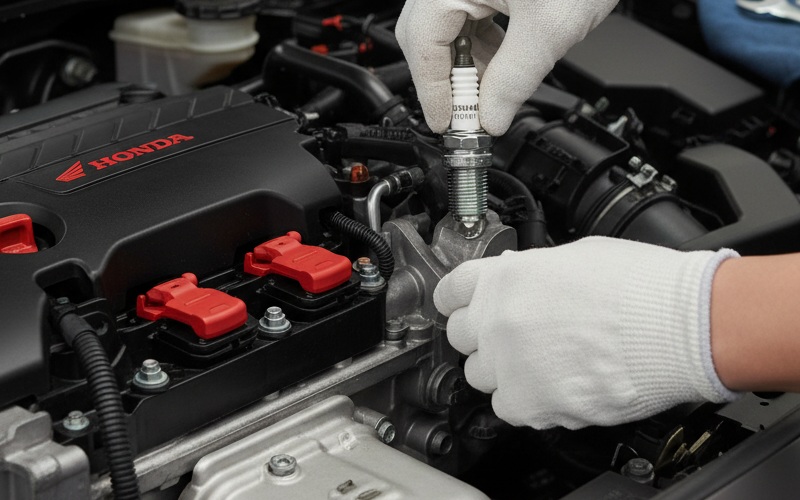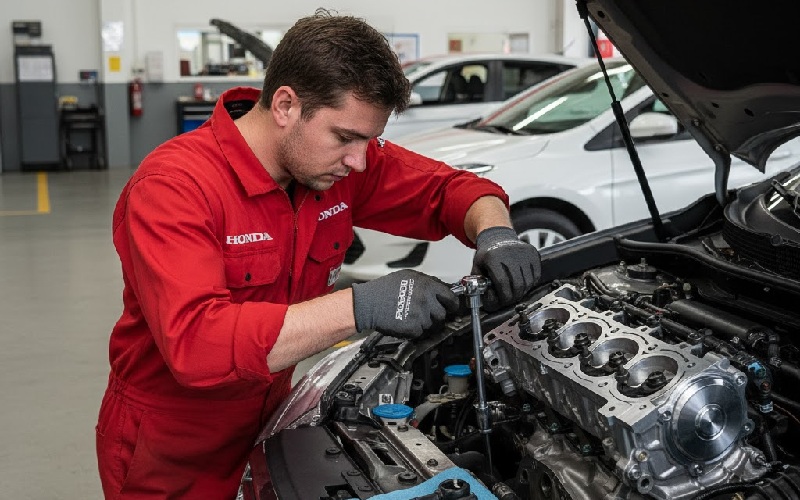Honda vehicles are known for their reliability and longevity, with properly maintained engines often running well beyond 300,000 kilometers. Honda Spark plugs play a crucial role in this reliability, serving as the ignition source for the air-fuel mixture that powers your engine. Understanding when to replace these essential components helps maintain optimal performance and fuel efficiency while preventing potential engine issues.

The Honda Maintenance Minder System
Unlike many manufacturers that recommend rigid service intervals based solely on distance travelled, Honda has implemented a more sophisticated approach with its Maintenance Minder system. This intelligent system monitors your driving habits, environmental conditions, and engine performance to determine exactly when maintenance is required.
How Maintenance Minder Works
The Maintenance Minder system calculates oil life percentage based on your driving conditions and displays codes when service is needed. When you see a Maintenance Minder code that includes the number “4,” it’s time to replace your Honda spark plugs. This typically appears as:
- A4 or B4 Service: Indicates spark plug replacement is needed, along with other maintenance items.
This approach ensures Honda spark plugs are replaced based on actual need rather than arbitrary time or distance intervals, potentially saving you unnecessary maintenance costs while keeping your vehicle in optimal condition.
Standard Honda Spark Plug Replacement Intervals
While the Maintenance Minder system provides customized recommendations, Honda does have general guidelines for spark plug replacement intervals that vary by model and plug type:
Conventional Honda Spark Plugs
Early Honda models using traditional nickel-alloy spark plugs typically required replacement every:
- 24,000 to 48,000 kilometers
Iridium or Double-Platinum Honda Spark Plugs
Modern Hondas equipped with long-life iridium or double-platinum spark plugs can go significantly longer between replacements:
- 100,000 to 160,000 kilometers
These intervals serve as general guidelines, with your vehicle’s specific Maintenance Minder recommendations taking precedence.
Replacement Intervals by Model
Different models have slightly different recommended spark plug replacement intervals based on their engine designs and intended use profiles.
Honda Civic
The Civic typically follows these Honda spark plug replacement intervals:
- 2006-2015 models: 100,000 kilometers
- 2016-2025 models with 1.5L turbocharged engines: 120,000 kilometers
- 2016-2025 models with 2.0L naturally aspirated engines: 100,000 kilometers
- Civic Type R: 60,000 kilometers (due to higher performance demands)
Honda Accord
The Accord’s replacement intervals vary by engine type:
- 4-cylinder models (2008-2025): 100,000 kilometers
- V6 models (2008-2017): 100,000 kilometers
- 1.5L turbocharged models (2018-2025): 120,000 kilometers
- 2.0L turbocharged models (2018-2025): 100,000 kilometers
Honda CR-V
The popular CR-V crossover follows these guidelines:
- 2.4L models (2007-2020): 100,000 kilometers
- 1.5L turbocharged models (2017-2025): 120,000 kilometers
Honda Pilot and Ridgeline
These larger vehicles with V6 engines typically need spark plug replacement at:
- All V6 models: 100,000 kilometers
Signs Your Honda Spark Plugs Need Replacement
Even with the reliable Honda Maintenance Minder system, it’s important to recognize symptoms of failing Honda spark plugs that might warrant early replacement:
Performance Issues
- Rough idle: Engine runs unevenly or vibrates when stationary
- Difficulty starting: Engine takes longer than normal to start
- Misfires: Engine hesitates or stumbles during acceleration
- Reduced power: Noticeable decrease in acceleration performance
Efficiency Concerns
- Decreased fuel economy: A sudden drop in fuel efficiency of 10% or more
- Increased emissions: Failed emissions tests or visible exhaust smoke
- Check Engine Light: Illuminated dashboard warning, especially with misfire codes (P0300-P0306)
If you experience these symptoms before your scheduled maintenance interval, it’s advisable to have your Honda spark plugs inspected regardless of the Maintenance Minder status.
Factors That Affect Spark Plug Lifespan
Several factors can influence how long your Honda spark plugs will last, potentially requiring replacement earlier or later than the standard intervals:
Driving Conditions
- Stop-and-go traffic: Frequent idling and short trips can accelerate spark plug wear
- Highway driving: Consistent high-speed driving generally allows plugs to last longer
- Extreme temperatures: Very cold climates may cause additional strain on ignition components
- Mountainous terrain: Frequent hill climbing puts extra demands on the engine
Fuel Quality
- Premium vs. regular fuel: Models designed for premium fuel may experience faster plug degradation when using regular fuel
- Ethanol content: Higher ethanol blends can affect combustion characteristics
- Fuel contaminants: Poor quality fuel may leave deposits on Honda spark plugs
Engine Condition
- Oil consumption: Engines that consume oil may foul spark plugs prematurely
- Carbon buildup: GDI engines (like those in newer CR-Vs and Accords) may experience more carbon deposit issues
- Engine modifications: Performance upgrades typically require more frequent spark plug maintenance
Spark Plug Types for Honda Vehicles
Honda uses different types of spark plugs across its vehicle lineup, with most modern models utilizing long-life materials:
NGK Laser Iridium
The most common OEM spark plugs in recent Honda models feature:
- Iridium center electrode
- Platinum ground electrode
- Fine-wire design for efficient ignition
- Extended service life
Denso Double Platinum
Found in some Honda models, these plugs offer:
- Platinum on both electrodes
- Good durability and performance
- Long service intervals
NGK SILZKR7C-11S
This specific spark plug is used in many 1.5L turbocharged Honda engines and features:
- Special heat range designed for turbocharged applications
- Enhanced durability under pressure
- Optimized for improved fuel economy
Using manufacturer-recommended Honda spark plugs ensures the best performance and longevity for your Honda engine.
DIY vs. Professional Replacement
While Honda spark plug replacement is a relatively straightforward maintenance task, modern Honda engines present some challenges that might make professional service the better option:
DIY Considerations
- Accessibility: Some models, like the V6 Accord, require intake manifold removal to access rear bank plugs
- Torque specifications: Critical to avoid thread damage (typically 13-18 Nm depending on model)
- Gap settings: Pre-gapped plugs are recommended, but verification is important
- Special tools: Some models require specialized spark plug sockets
Professional Advantage
- Diagnostic capability: Technicians can identify related issues
- Proper tools: Honda dealerships have model-specific tools for easier access
- Warranty consideration: Maintains service records for warranty purposes
- Comprehensive service: Often combined with other maintenance items
Whether choosing DIY or professional service, using OEM or equivalent quality spark plugs is essential for maintaining your Honda performance and reliability.
When to Replace Honda Spark Plugs
The standard Honda recommendation for most modern vehicles equipped with iridium spark plugs is replacement at 100,000 to 120,000 kilometers, depending on the model and engine type. However, the Maintenance Minder system provides the most accurate guidance based on your specific driving conditions.
For most drivers, Honda spark plug replacement typically occurs at approximately 5-7 years of ownership, although this varies significantly based on driving habits. Performance models like the Civic Type R and vehicles frequently used in severe conditions may require more frequent replacement.
The best practice is to follow your vehicle’s Maintenance Minder recommendations when the “4” service indicator appears, while remaining alert to any symptoms of failing Honda spark plugs that might warrant earlier inspection.
By maintaining proper spark plug replacement intervals, you’ll ensure your Honda continues to deliver the reliability, efficiency, and performance that made it famous in the first place.
Facts About Honda Spark Plugs
- Iridium spark plugs contain one of the rarest elements on Earth, as iridium is more scarce than gold and is primarily found in meteorites.
- The first-generation Honda Insight hybrid utilized special platinum spark plugs with an extremely fine center electrode (0.4mm) to enhance efficiency, making it one of the smallest in any production vehicle.
- VTEC engines often utilize spark plugs with different heat ranges than their non-VTEC counterparts of the same displacement to accommodate the higher RPM operation.
- The Honda NSX supercar uses specially developed spark plugs with iridium-rhodium alloy tips that can withstand temperatures up to 1,300°C to handle the extreme combustion pressures.
- Honda Formula 1 racing engines used during their partnership with McLaren required spark plug replacement after just 300 kilometers due to the extreme operating conditions, compared to the 100,000+ kilometers in road cars.
*Disclaimer: Content contained in this post is for informational purposes only and may include features and options from US or international models. Please contact the dealership for more information or to confirm vehicle, feature availability.*




